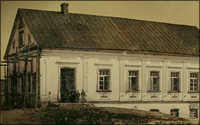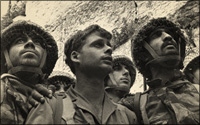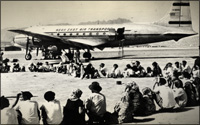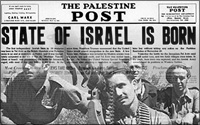 The coming of Haskalah in Eastern Europe challenged the traditional Jewish community and drew out from it various reactions. One was the Yeshiva Movement. Indeed, the rise of the new yeshivas (academies of higher Jewish learning) in Eastern Europe was the main defense and main bastion of strength to oppose the Haskalah, and to guarantee the furtherance of traditional Judaism.
The coming of Haskalah in Eastern Europe challenged the traditional Jewish community and drew out from it various reactions. One was the Yeshiva Movement. Indeed, the rise of the new yeshivas (academies of higher Jewish learning) in Eastern Europe was the main defense and main bastion of strength to oppose the Haskalah, and to guarantee the furtherance of traditional Judaism.
The Yeshiva Movement, especially in the town of Volozhin, was in itself revolutionary. Today, it has become the establishment. Once an innovative idea becomes the establishment, it’s hard to imagine it in its formative early years, in its revolutionary form. However, two centuries ago the yeshiva system as we know it today was revolutionary.
Rabbi Chaim of Volozhin
There are three main yeshivas that we can identify as the forerunners of the movement. One was the yeshiva in Volozhin, a small town between Minsk and Vilna in Lithuanian Russia. The second was in Lemberg (also known as Lvov), in Polish Galicia. The third was in Pressburg, which then was part of the Austro-Hungarian Empire under the Hapsburg dynasty, and today is the city of Bratislava in Slovakia on the Hungarian border.
Volozhin is probably the most famous, because the yeshiva movement took root most strongly in Lithuanian Russia. Its influence and ideals, and in fact its curriculum, to a great extent, govern the operation of yeshivas today.
The founder of the yeshiva, Rabbi Chaim of Volozhin (popularly known as “Reb Chaim Volozhiner” or simply as “Reb Chaim”), was the main disciple of the Gaon of Vilna. Possessing great intellect, he enjoyed the reputation far and wide as the leading Talmudic scholar of his time — in a time when there were many great Talmudic scholars. He had discussed his idea about founding a yeshiva with the Vilna Gaon, according to sources within his family, in 1792.
A Central Place of Learning
Rabbi Chaim’s revolutionary idea was fourfold.
First, was to have a central place of learning. Until then, the system of learning in Eastern Europe was that boys went to cheder (literally “a room,” but more broadly an elementary school) from about the time they turned three until about bar mitzvah. Some stopped at 11 or 12. Most young Jewish men were working by the time they were bar mitzvah. The elite — those who showed promise in their Talmudic studies, or who came from the upper classes, or from rabbinic homes — continued their education into their adolescent years and beyond, usually by studying with the rabbi of the town in which they lived. That was part of the task of the rabbi, to conduct the study sessions with whoever came to learn. If the young man showed particular promise, then he was sent out of town to the cities of noted rabbinical scholars, where he would learn with that rabbinic scholar for a period of time. Then, finally, when he attained sufficient knowledge he would be ordained, usually by a number of rabbis.
It was a very loose system, not institutionalized. It had the great advantage of being personalized and inexpensive. Nevertheless, Reb Chaim saw, correctly, that such a system would not be able to continue in the coming times. The winds of change were blowing from Western Europe. Previously, a boy with a good Jewish mind had a choice: study the Talmud or become, say, a carpenter. But he was not going to pick up Plato. However, beginning in the middle of the 1700s, and with the advent of the Enlightenment, Reform and Haskalah, there was now competition. Good Jewish minds could find something other than Torah to occupy them. Those other things were not necessarily beneficial for the Jewish people, but they were available.
Therefore, the first point that Reb Chaim made to the Gaon of Vilna was the need for a central institution of higher learning that would so strengthen and raise the level of Torah study to challenge the students and be competition to any other form of intellectual pursuit.
Catering to the Elite
Implicit in that was the second point, that it would be an institution for the best minds in the Jewish world.
Today, the purpose of the typical yeshiva is different — because the world is different. Today, if a student doesn’t go to yeshiva high school, or post-high school, the chances are that he won’t remain a Sabbath-observant Jew. Today the yeshiva is a haven to produce Torah observant Jews. In the Europe of 100-200 years ago, observance was assumed; the purpose of the yeshiva was to produce leaders.
Volozhin was founded to bring about an esprit de corps among the student body that made the best even better; that developed really superior people.
A third point that Rabbi Chaim include in his blueprint for the Yeshiva Movement was that Torah had to be learned as community, not as individuals. In any yeshiva today the students are learning out loud in pairs or groups in the same room, noisy and distractive as that may. It is not like walking into a public library, where if one person coughs everyone lifts up his head from his book and gives him a look.
The genius behind that is that there is enthusiasm in numbers. The noise itself raises the pitch and the level of Torah study. If you visit large yeshivas that have a few hundred boys learning all at once, you will find that it is an emotional, psychological and educational experience.
Finally, the fourth point Reb Chaim made was that true joy lay in the intellectual exhilaration of Torah study and Torah knowledge, not necessarily in dancing, song and good fellowship. That may have been an oblique reference to the Chassidic emphasis on joy.
The Legend
That was the program that Reb Chaim outlined to the Gaon of Vilna.
Legend has it that even though he told his plan to the Gaon with great enthusiasm, the Gaon did not respond positively. Since Reb Chaim, would not undertake a project of this nature without his approval, he dropped it.
The legend also has it that a number of years later, immediately before the death of the Vilna Gaon, Reb Chaim again spoke to him about the project — this time with much less enthusiasm and much less confidence. Surprisingly, the Gaon told him that it was a wonderful idea and that he should proceed!
“Master,” he inquired, “when I first asked about it I was so enthusiastic, and you cooled me off. Why, suddenly, you are now in favor of it?”
“The first time you asked me about it,” the Gaon responded, “too much of your ego was involved. You wanted to make it. It would not have succeeded. Now you talk about it much more calmly — with more doubts, more rationally, with less personality and ego involved. It’s a great idea. Go ahead and do it.”
The Volozhin Devotion to Torah
When the yeshiva in Volozhin began Reb Chaim was its head, the “Rosh Yeshiva.”
Devotion to learning knew no limits. The average day in Volozhin was 18 hours. There were those who learned 36 hours consecutively (that’s where medical schools got the idea). Then they would sleep 8 or 10 hours, then learn another 36 hours consecutively again.
There was an institutional goal for at least some to be learning 24 hours a day, 7 days a week, all year. They had special arrangements during those times of the year when obligations such as the day before Passover or Yom Kippur or immediately after the fast might threaten to break the continuity of learning. These arrangements included a lottery as to which students would learn then. Other students would see to their needs, bring them food, etc.
This devotion to learning on a mass scale raised the level and the honor of Torah exponentially. Students felt that Torah was worth everything.
The curriculum consisted of the entire Talmud, from beginning to end. Later, in the Lithuanian yeshivas, the curriculum would be narrowed down to seven to ten volumes of the Talmud. However, in Volozhin it was the entire Talmud. There were many students who finished it in depth once or twice during their sojourn in Volozhin.
Reb Iztele
Reb Chaim headed the yeshiva until 1825. He had a son, Rabbi Yitzchak, who was called “Reb Itzele.”
When Reb Chaim died, Reb Itzele became head of the yeshiva and the chief rabbi in Volozhin. When Reb Itzele died, around 1854-55, his son-in-law, Rabbi Eliezar Fried, became the head of the yeshiva, together with Rabbi Yoshe Ber Soloveitchik, a direct grandson of Reb Chaim.
Reb Itzele had a son-in-law, Rabbi Naftali Tzvi Yehuda Berlin, who would become famous and called by the acronym, “the Netziv” (which in Hebrew means “the Prince”). Naftali Tzvi Yehuda Berlin married into the family when he was only 14. He learned for 10 years in his father-in-law’s house, but his greatness was not readily apparent at first. Rabbi Eliezar Fried, Reb Itzele’s other son-in-law, was far more well-known for his Talmudic prowess.
Nevertheless, while yet in his father-in-law’s house, the Netziv wrote a commentary to the eight century classic Sheiltos d’Rabbi Chai Gaon, which was authored by Rabbi Hai Gaon, one of the greatest Jewish scholars in the post-Talmudic era. For all its greatness, Rabbi Hai Gaon’s book was written in a way that is very hard to understand, and, therefore it never was very popular. However, the commentary of the Netziv opened up the book, at the same time it showed the Jewish scholarly world how great the Netziv was.
The first volume, which he titled Ha’emek Shailah, was published while the Netziv was in his mid-20s. Suddenly, the scholarly Jewish world realized that they were dealing with a top-tier intellect and scholar.
Succession Issues
Rabbi Eliezar Fried died less than two years after his father-in-law, Rabbi Chaim Volozhiner, which left open the question of who would lead the rabbinate and become the head of the yeshiva: the Netziv or Rabbi Yoshe Ber Soloveitchik. Rabbi Yoshe Ber was not only a true, rare genius, but also had great charisma (even though he lived a tragic personal life).
They decided that they would submit the matter to a Jewish court. There was no personal animosity between them, but for the sake of the yeshiva and its direction they realized that they had to submit the decision to an objective third party.
The final decision defied expectations: the Netziv would be the head of the yeshiva. Rabbi Yoshe Ber Soloveitchik accepted the verdict, and soon afterward he left Volozhin to become the rabbi in Slutsk and later in Brisk.
Rav Yoshe Ber Soloveitchik had a son, Rabbi Chaim Soloveitchik¸ a child prodigy, who later became one of the great men of Israel. Rabbi Chaim Soloveitchik married the granddaughter of the Netziv. Therefore, the families became one, and Rabbi Chaim Soloveitchik became the next Rosh Yeshiva in Volozhin together with his grandfather.
It was the high point of this period, when Volozhin reached its peak in terms of quality of students, and when Rabbi Chaim Soloveitchik developed his signature analytical approach to explanations regarding the Talmud and Maimonides, often referred to today as the Brisk approach. Offshoots of Brisk yeshivas exist all over the world to this day in the United States and Israel.
The End of Volozhin
Volozhin was personified by these two people: the Netziv and Rabbi Chaim Soloveitchik. At its peak the institution grew to 450 students.
The Russian government, through the efforts of the Maskilim, put great pressure on Volozhin to teach Russian subjects. The Netziv and Rabbi Chaim came to an accommodation with the Russians for almost 10 years during which perfunctory classes in Russian subjects were taught outside the yeshiva on a private basis. But it never intended to have Russian studies as part of its main curriculum.
Losing patience with the Jews generally, and again at the instigation of the Maskilim, the Russian government finally realized that Volozhin was producing the spiritual armaments necessary to defeat Russia’s attempt to destroy and assimilate the Jews. As long as Volozhin kept producing Jewish leaders, generation after generation, the government and the Russian Orthodox Church were not going to succeed. When they finally realized that, they decided to close the institution.
In 1892, the government issued an ultimatum that the yeshiva conform to the official standards, or they would close it. They drove the students out of the yeshiva and disbanded it. Legend has it that the Netziv himself put the lock on the door, rather than give in to the demands of the government.
In retrospect, he was correct. The closure of Volozhin led to the opening of a number of Lithuanian yeshivas that became, in the late 1900s and early 1900s, the fountainhead of knowledge and scholarship in traditional Judaism. Nevertheless, the closing of the yeshiva broke the heart of the Netziv and of Rabbi Chaim Soloveitchik. When the latter’s father died he became the rabbi in Brisk but he never was the same person that he had been in the yeshiva.
The Netziv decided to go to the Land of Israel. However, he only made it as far as Warsaw, where he died.
Though these great men died without their yeshiva, their efforts and legend lived on, and lives on, empowering the Jewish people with the spiritual backbone to survive arguably the most difficult times in its long and difficult history.











